check engine light Acura ILX 2016 Owner's Guide
[x] Cancel search | Manufacturer: ACURA, Model Year: 2016, Model line: ILX, Model: Acura ILX 2016Pages: 78, PDF Size: 20.92 MB
Page 4 of 78
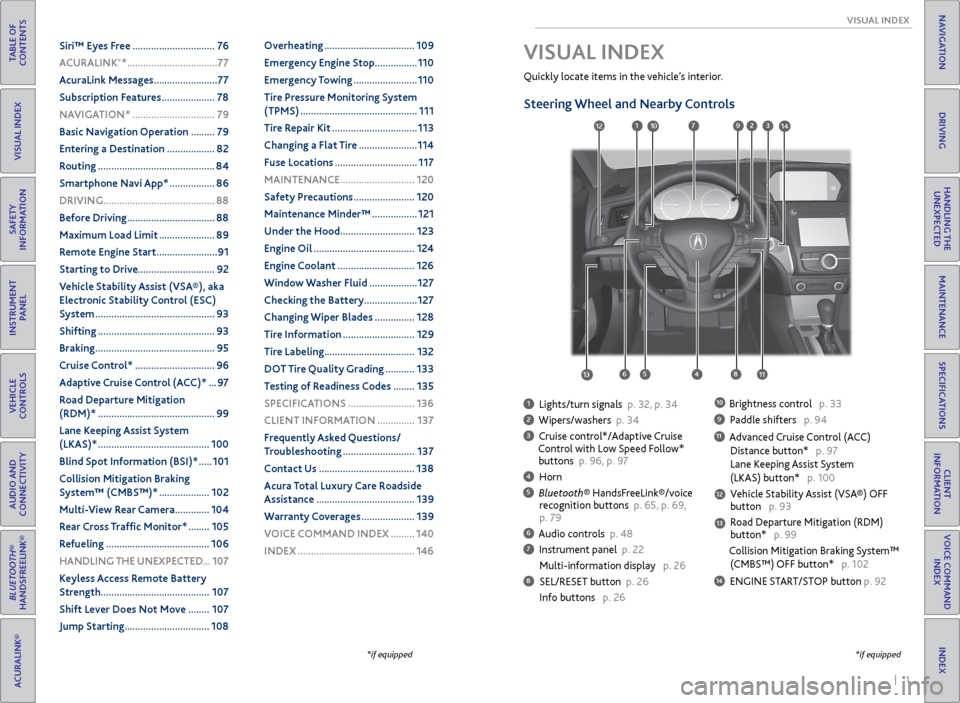
| 1
VISUAL INDEX
INDEX
VOICE COMMAND
INDEX
CLIENT
INFORMATION
SPECIFICATIONS
MAINTENANCE
HANDLING THE UNEXPECTED
DRIVING
NAVIGATION
TABLE OF
CONTENTS
VISUAL INDEX
SAFETY
INFORMATION
INSTRUMENT PANEL
VEHICLE
CONTROLS
AUDIO AND
CONNECTIVITY
BLUETOOTH®
HANDSFREELINK®
ACURALINK®
1 Lights/turn signals p. 32, p. 34
2 Wipers/washers p. 34
3 Cruise control*/Adaptive Cruise
Control with Low Speed Follow*
buttons p. 96, p. 97
4 Horn
5 Bluetooth® HandsFreeLink®/voice recognition buttons p. 65, p. 69,
p. 79
6 Audio controls p. 48
7 Instrument panel p. 22
Multi-information display p. 26
8 SEL/RESET button p. 26
Info buttons p. 26
Quickly locate items in the vehicle’s interior.
Steering Wheel and Nearby Controls
Brightness control p. 33
9 Paddle shifters p. 94
11 Advanced Cruise Control (ACC)
Distance button* p. 97
Lane Keeping Assist System
(LKAS) button* p. 100
Vehicle Stability Assist (VSA®) OFF
button p. 93
Road Departure Mitigation (RDM)
button* p. 99
Collision Mitigation Braking System™
(CMBS™) OFF button* p. 102
14 ENGINE START/STOP button p. 92
10
VISUAL INDEX
*if equipped
127
4
12
6
14
*if equipped
58
9
12
13
13
103
11
Siri™ Eyes Free ............................... 76
A CURALINK
®* .................................. 77
AcuraLink Messages ........................ 77
Subscription Features .................... 78
NAVIGATION* ............................... 79
Basic Navigation Operation ......... 79
Entering a Destination .................. 82
Routing ............................................ 84
Smartphone Navi App* ................. 86
DRIVING .......................................... 88
Before Driving ................................. 88
Maximum Load Limit ..................... 89
Remote Engine Start ....................... 91
Starting to Drive ............................. 92
Vehicle Stability Assist (VSA®), aka
Electronic Stability Control (ESC)
System ............................................. 93
Shifting ............................................ 93
Braking ............................................. 95
Cruise Control* .............................. 96
Adaptive Cruise Control (ACC)* ... 97
Road Departure Mitigation
(RDM)* ............................................ 99
Lane Keeping Assist System
(LKAS)* .......................................... 100
Blind Spot Information (BSI)* ..... 101
Collision Mitigation Braking
System™ (CMBS™)* ................... 102
Multi-View Rear Camera ............. 104
Rear Cross Traffic Monitor* ........ 105
Refueling ....................................... 106
HANDLING THE UNEXPECTED ...107
Keyless Access Remote Battery
Strength ......................................... 107
Shift Lever Does Not Move ........ 107
Jump Starting ................................ 108Overheating ..................................
109
Emergency Engine Stop ................ 110
Emergency Towing ........................ 110
Tire Pressure Monitoring System
(TPMS) ............................................ 111
Tire Repair Kit ................................ 113
Changing a Flat Tire ...................... 114
Fuse Locations ............................... 117
MAINTENANCE ............................ 120
Safety Precautions ....................... 120
Maintenance Minder™ ................. 121
Under the Hood ............................ 123
Engine Oil ...................................... 124
Engine Coolant ............................. 126
Window Washer Fluid .................. 127
Checking the Battery .................... 127
Changing Wiper Blades ............... 128
Tire Information ........................... 129
Tire Labeling .................................. 132
DOT Tire Quality Grading ........... 133
Testing of Readiness Codes ........ 135
SPECIFICATIONS ......................... 136
CLIENT INFORMATION .............. 137
Frequently Asked Questions/
Troubleshooting ........................... 137
Contact Us .................................... 138
Acura Total Luxury Care Roadside
Assistance ..................................... 139
Warranty Coverages .................... 139
V OICE COMMAND INDEX ......... 140
INDEX ............................................ 146
Page 15 of 78
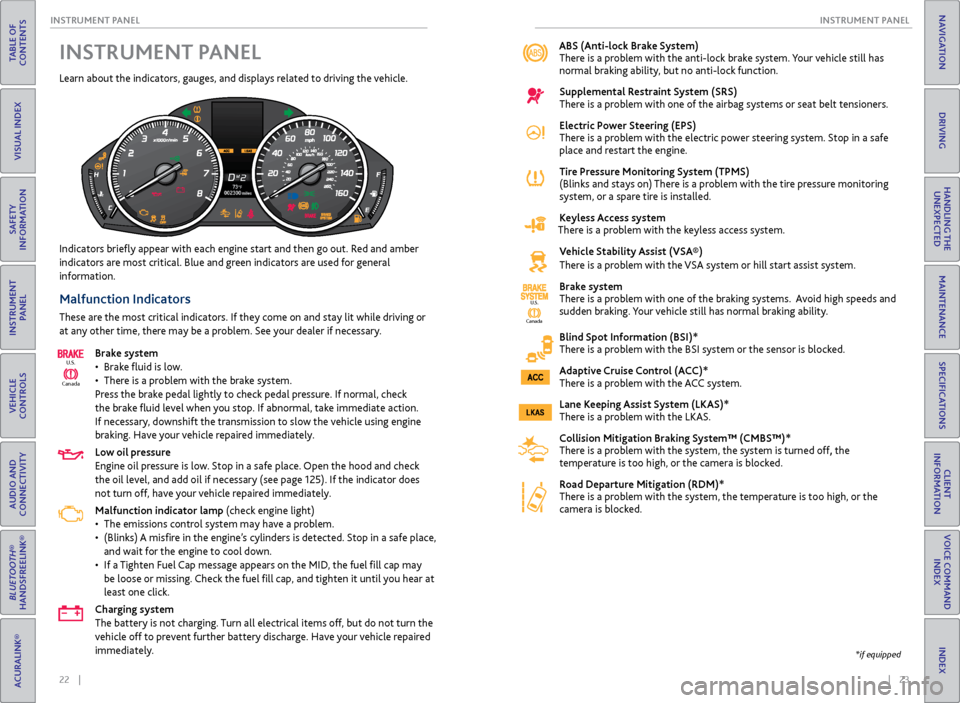
22 || 23
INSTRUMENT P
ANEL
INSTRUMENT P ANEL
TABLE OF
CONTENTS
INDEX
VISUAL INDEX
VOICE COMMAND INDEX
SAFETY
INFORMATION
CLIENT
INFORMATION
INSTRUMENT PANEL
SPECIFICATIONS
VEHICLE
CONTROLS
MAINTENANCE
AUDIO AND
CONNECTIVITY
HANDLING THE UNEXPECTED
BLUETOOTH®
HANDSFREELINK®
DRIVING
ACURALINK®
NAVIGATION
ABS (Anti-lock Brake System)
There is a problem with the anti-lock brake system. Your vehicle still has
normal braking ability, but no anti-lock function.
Supplemental Restraint System (SRS)
There is a problem with one of the airbag systems or seat belt tensioners.
Electric Power Steering (EPS)
There is a problem with the electric power steering system. Stop in a safe
place and restart the engine.
Tire Pressure Monitoring System (TPMS)
(Blinks and stays on) There is a problem with the tire pressure monitoring
system, or a spare tire is installed.
Keyless Access system
There is a problem with the keyless access system.
Vehicle Stability Assist (VSA®)
There is a problem with the VSA system or hill start assist system.
Brake system
There is a problem with one of the braking systems. Avoid high speeds and
sudden braking. Your vehicle still has normal braking ability.
Blind Spot Information (BSI)*
There is a problem with the BSI system or the sensor is blocked.
Adaptive Cruise Control (ACC)*
There is a problem with the ACC system.
Lane Keeping Assist System (LKAS)*
There is a problem with the LKAS.
Collision Mitigation Braking System™ (CMBS™)*
There is a problem with the system, the system is turned off, the
temperature is too high, or the camera is blocked.
Road Departure Mitigation (RDM)*
There is a problem with the system, the temperature is too high, or the
camera is blocked.
Indicators briefly appear with each engine start and then go out. Red and amber
indicators are most critical. Blue and green indicators are used for general
information.
Malfunction Indicators
These are the most critical indicators. If they come on and stay lit while driving or
at any other time, there may be a problem. See your dealer if necessary.
Brake system
• Brake fluid is low.
• There is a problem with the brake system.
Press the brake pedal lightly to check pedal pressure. If normal, check
the brake fluid level when you stop. If abnormal, take immediate action.
If necessary, downshift the transmission to slow the vehicle using engine
braking. Have your vehicle repaired immediately.
Low oil pressure
Engine oil pressure is low. Stop in a safe place. Open the hood and check
the oil level, and add oil if necessary (see page 125). If the indicator does
not turn off, have your vehicle repaired immediately.
Malfunction indicator lamp (check engine light)
• The emissions control system may have a problem.
• (Blinks) A misfire in the engine’s cylinders is detected. Stop in a safe place,
and wait for the engine to cool down.
• If a Tighten Fuel Cap message appears on the MID, the fuel fill cap may
be loose or missing. Check the fuel fill cap, and tighten it until you hear at
least one click.
Charging system
The battery is not charging. Turn all electrical items off, but do not turn the
vehicle off to prevent further battery discharge. Have your vehicle repaired
immediately.
Ca nada
U.S.
INSTRUMENT P
ANEL
Learn about the indicators, gauges, and displays related to driving the vehicle.
Canada
U.S.
*if equipped
Page 16 of 78
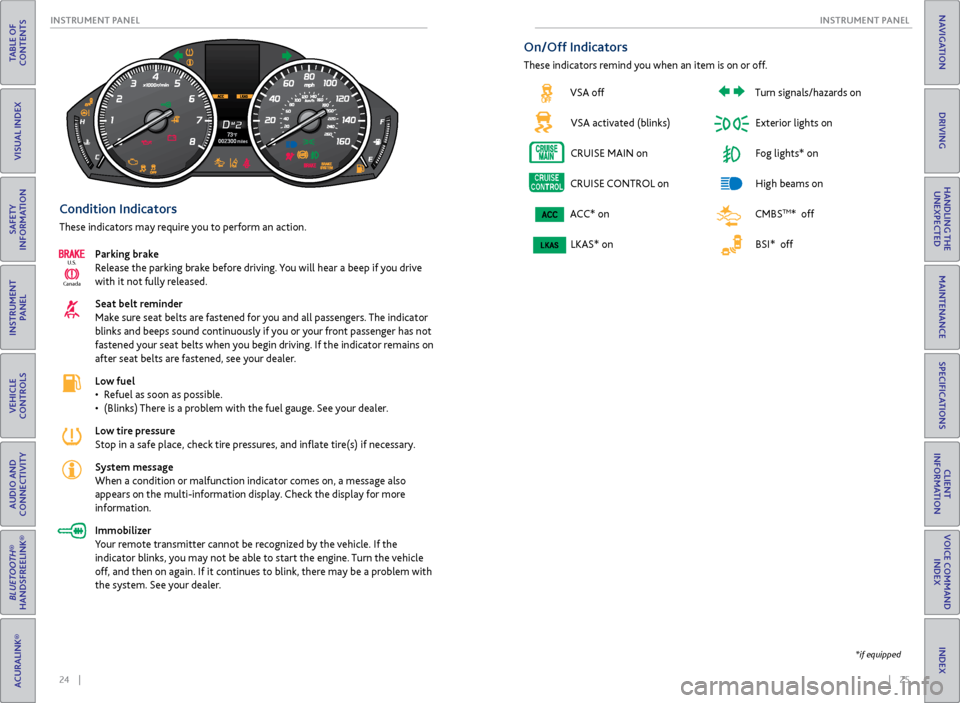
24 || 25
INSTRUMENT P
ANEL
INSTRUMENT P ANEL
TABLE OF
CONTENTS
INDEX
VISUAL INDEX
VOICE COMMAND INDEX
SAFETY
INFORMATION
CLIENT
INFORMATION
INSTRUMENT PANEL
SPECIFICATIONS
VEHICLE
CONTROLS
MAINTENANCE
AUDIO AND
CONNECTIVITY
HANDLING THE UNEXPECTED
BLUETOOTH®
HANDSFREELINK®
DRIVING
ACURALINK®
NAVIGATION
Turn signals/hazards on
Exterior lights on
Fog lights* on
High beams on
CMBS
TM* off
BSI* offCondition Indicators
These indicators may require you to perform an action. Parking brake
Release the parking brake before driving. You will hear a beep if you drive
with it not fully released.
Seat belt reminder
Make sure seat belts are fastened for you and all passengers. The indicator
blinks and beeps sound continuously if you or your front passenger has not
fastened your seat belts when you begin driving. If the indicator remains on
after seat belts are fastened, see your dealer.
Low fuel
• Refuel as soon as possible.
• (Blinks) There is a problem with the fuel gauge. See your dealer.
Low tire pressure
Stop in a safe place, check tire pressures, and inflate tire(s) if necessary.
System message
When a condition or malfunction indicator comes on, a message also
appears on the multi-information display. Check the display for more
information.
Immobilizer
Your remote transmitter cannot be recognized by the vehicle. If the
indicator blinks, you may not be able to start the engine. Turn the vehicle
off, and then on again. If it continues to blink, there may be a problem with
the system. See your dealer.
On/Off Indicators
These indicators remind you when an item is on or off.
*if equipped
VSA off
VSA activated (blinks)
CRUISE MAIN on
CRUISE CONTROL on
ACC* on LKAS* on
Ca nada
U.S.
Page 48 of 78
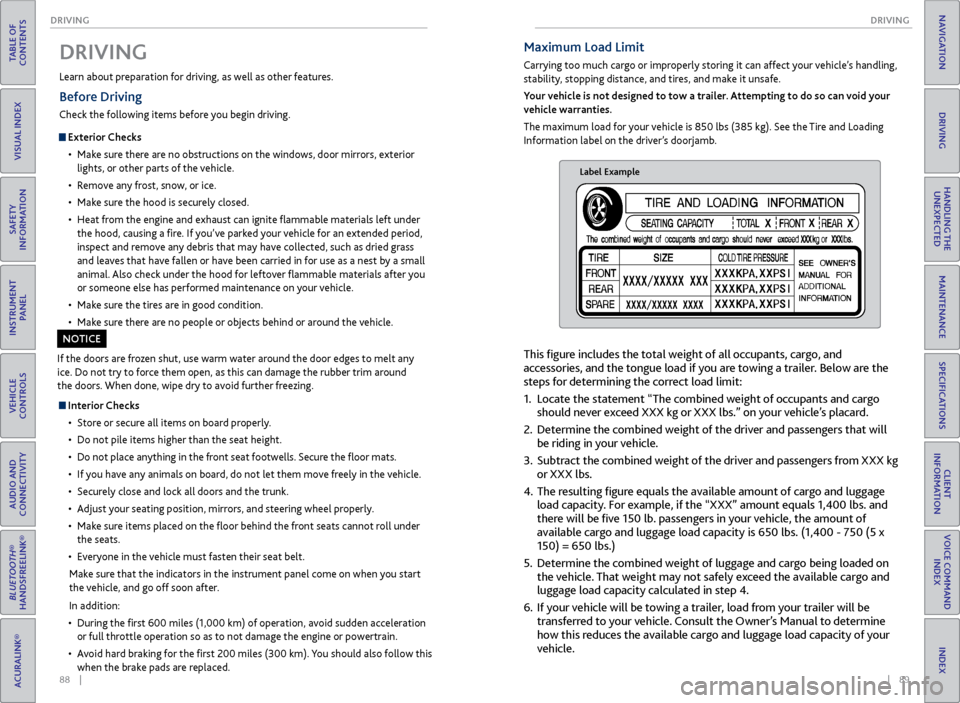
88 || 89
DRIVING
DRIVING
TABLE OF
CONTENTS
INDEX
VISUAL INDEX
VOICE COMMAND INDEX
SAFETY
INFORMATION
CLIENT
INFORMATION
INSTRUMENT PANEL
SPECIFICATIONS
VEHICLE
CONTROLS
MAINTENANCE
AUDIO AND
CONNECTIVITY
HANDLING THE UNEXPECTED
BLUETOOTH®
HANDSFREELINK®
DRIVING
ACURALINK®
NAVIGATION
Learn about preparation for driving, as well as other features.
DRIVING
If the doors are frozen shut, use warm water around the door edges to melt any
ice. Do not try to force them open, as this can damage the rubber trim around
the doors. When done, wipe dry to avoid further freezing.
NOTICE
Interior Checks
• Store or secure all items on board properly.
• Do not pile items higher than the seat height.
• Do not place anything in the front seat footwells. Secure the floor mats.
• If you have any animals on board, do not let them move freely in the vehicle.
• Securely close and lock all doors and the trunk.
• Adjust your seating position, mirrors, and steering wheel properly.
• Make sure items placed on the floor behind the front seats cannot roll under
the seats.
• Everyone in the vehicle must fasten their seat belt.
Make sure that the indicators in the instrument panel come on when you start
the vehicle, and go off soon after.
In addition:
• During the first 600 miles (1,000 km) of operation, avoid sudden acceleration
or full throttle operation so as to not damage the engine or powertrain.
• Avoid hard braking for the first 200 miles (300 km). You should also follow this
when the brake pads are replaced.
Before Driving
Check the following items before you begin driving.
Exterior Checks
• Make sure there are no obstructions on the windows, door mirrors, exterior
lights, or other parts of the vehicle.
• Remove any frost, snow, or ice.
• Make sure the hood is securely closed.
• Heat from the engine and exhaust can ignite flammable materials left under
the hood, causing a fire. If you’ve parked your vehicle for an extended period,
inspect and remove any debris that may have collected, such as dried grass
and leaves that have fallen or have been carried in for use as a nest by a small
animal. Also check under the hood for leftover flammable materials after you
or someone else has performed maintenance on your vehicle.
• Make sure the tires are in good condition.
• Make sure there are no people or objects behind or around the vehicle.
Maximum Load Limit
Carrying too much cargo or improperly storing it can affect your vehicle’s handling,
stability, stopping distance, and tires, and make it unsafe.
Your vehicle is not designed to tow a trailer. Attempting to do so can void your
vehicle warranties.
The maximum load for your vehicle is 850 lbs (385 kg). See the Tire and Loading
Information label on the driver’s doorjamb.
Label Example
This figure includes the total weight of all occupants, cargo, and
accessories, and the tongue load if you are towing a trailer. Below are the
steps for determining the correct load limit:
1. Locate the statement “The combined weight of occupants and cargo
should never exceed XXX kg or XXX lbs.” on your vehicle’s placard.
2. Determine the combined weight of the driver and passengers that will
be riding in your vehicle.
3. Subtract the combined weight of the driver and passengers from XXX kg
or XXX lbs.
4. The resulting figure equals the available amount of cargo and luggage
load capacity. For example, if the “XXX” amount equals 1,400 lbs. and
there will be five 150 lb. passengers in your vehicle, the amount of
available cargo and luggage load capacity is 650 lbs. (1,400 - 750 (5 x
150) = 650 lbs.)
5. Determine the combined weight of luggage and cargo being loaded on
the vehicle. That weight may not safely exceed the available cargo and
luggage load capacity calculated in step 4.
6. If your vehicle will be towing a trailer, load from your trailer will be
transferred to your vehicle. Consult the Owner’s Manual to determine
how this reduces the available cargo and luggage load capacity of your
vehicle.
Page 58 of 78
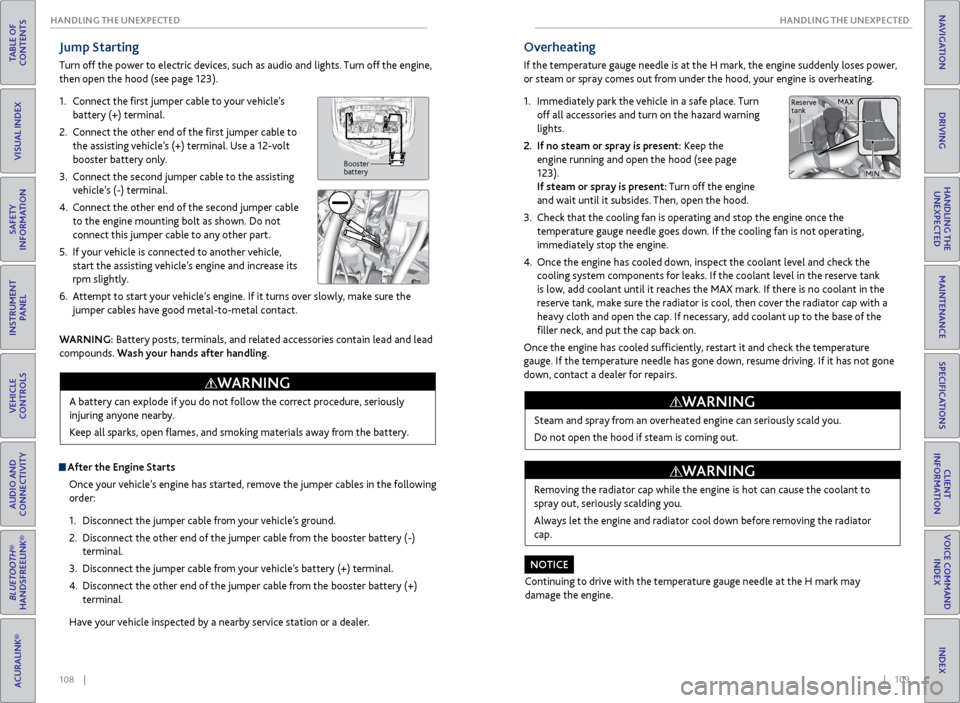
108 || 109
HANDLING THE UNEXPECTED
HANDLING THE UNEXPECTED
TABLE OF
CONTENTS
INDEX
VISUAL INDEX
VOICE COMMAND INDEX
SAFETY
INFORMATION
CLIENT
INFORMATION
INSTRUMENT PANEL
SPECIFICATIONS
VEHICLE
CONTROLS
MAINTENANCE
AUDIO AND
CONNECTIVITY
HANDLING THE UNEXPECTED
BLUETOOTH®
HANDSFREELINK®
DRIVING
ACURALINK®
NAVIGATION
Jump Starting
Turn off the power to electric devices, such as audio and lights. Turn off the engine,
then open the hood (see page 123).
1. Connect the first jumper cable to your vehicle’s
battery (+) terminal.
2. Connect the other end of the first jumper cable to
the assisting vehicle’s (+) terminal. Use a 12-volt
booster battery only.
3. Connect the second jumper cable to the assisting
vehicle’s (-) terminal.
4. Connect the other end of the second jumper cable
to the engine mounting bolt as shown. Do not
connect this jumper cable to any other part.
5. If your vehicle is connected to another vehicle,
start the assisting vehicle’s engine and increase its
rpm slightly.
6. Attempt to start your vehicle’s engine. If it turns over slowly, make sure the
jumper cables have good metal-to-metal contact.
Booster
battery
WARNING: Battery posts, terminals, and related accessories contain lead and lead
compounds. Wash your hands after handling.
After the Engine Starts
Once your vehicle’s engine has started, remove the jumper cables in the following
order:
1. Disconnect the jumper cable from your vehicle’s ground.
2. Disconnect the other end of the jumper cable from the booster battery (-)
terminal.
3. Disconnect the jumper cable from your vehicle’s battery (+) terminal.
4. Disconnect the other end of the jumper cable from the booster battery (+)
terminal.
Have your vehicle inspected by a nearby service station or a dealer. A battery can explode if you do not follow the correct procedure, seriously
injuring anyone nearby.
Keep all sparks, open flames, and smoking materials away from the battery.
WARNING
Overheating
If the temperature gauge needle is at the H mark, the engine suddenly loses power,
or steam or spray comes out from under the hood, your engine is overheating.
1.
Immediately park the vehicle in a safe place. Turn
off all accessories and turn on the hazard warning
lights.
2. If no steam or spray is present: Keep the
engine running and open the hood (see page
123).
If steam or spray is present: Turn off the engine
and wait until it subsides. Then, open the hood.
3. Check that the cooling fan is operating and stop the engine once the
temperature gauge needle goes down. If the cooling fan is not operating,
immediately stop the engine.
4. Once the engine has cooled down, inspect the coolant level and check the
cooling system components for leaks. If the coolant level in the reserve tank
is low, add coolant until it reaches the MAX mark. If there is no coolant in the
reserve tank, make sure the radiator is cool, then cover the radiator cap with a
heavy cloth and open the cap. If necessary, add coolant up to the base of the
filler neck, and put the cap back on.
Once the engine has cooled sufficiently, restart it and check the temperature
gauge. If the temperature needle has gone down, resume driving. If it has not gone
down, contact a dealer for repairs.
Steam and spray from an overheated engine can seriously scald you.
Do not open the hood if steam is coming out.
WARNING
Removing the radiator cap while the engine is hot can cause the coolant to
spray out, seriously scalding you.
Always let the engine and radiator cool down before removing the radiator
cap.
WARNING
Continuing to drive with the temperature gauge needle at the H mark may
damage the engine.
NOTICE
Reserve
tank MAX
MIN
Page 62 of 78
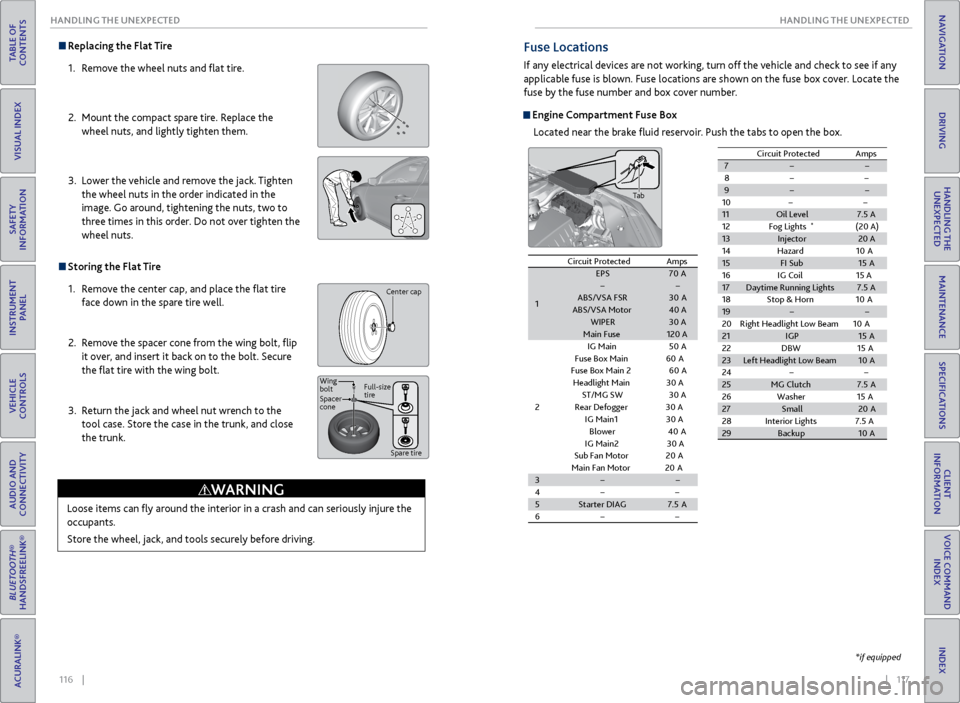
116 || 117
HANDLING THE UNEXPECTED
HANDLING THE UNEXPECTED
TABLE OF
CONTENTS
INDEX
VISUAL INDEX
VOICE COMMAND INDEX
SAFETY
INFORMATION
CLIENT
INFORMATION
INSTRUMENT PANEL
SPECIFICATIONS
VEHICLE
CONTROLS
MAINTENANCE
AUDIO AND
CONNECTIVITY
HANDLING THE UNEXPECTED
BLUETOOTH®
HANDSFREELINK®
DRIVING
ACURALINK®
NAVIGATION
Replacing the Flat Tire
1. Remove the wheel nuts and flat tire.
2. Mount the compact spare tire. Replace the
wheel nuts, and lightly tighten them.
3. Lower the vehicle and remove the jack. Tighten
the wheel nuts in the order indicated in the
image. Go around, tightening the nuts, two to
three times in this order. Do not over tighten the
wheel nuts.
Storing the Flat Tire
1. Remove the center cap, and place the flat tire
face down in the spare tire well.
2. Remove the spacer cone from the wing bolt, flip
it over, and insert it back on to the bolt. Secure
the flat tire with the wing bolt.
3. Return the jack and wheel nut wrench to the
tool case. Store the case in the trunk, and close
the trunk.
Loose items can fly around the interior in a crash and can seriously injure the
occupants.
Store the wheel, jack, and tools securely before driving.
WARNING
Center cap
Spacer
cone Wing
bolt Full-size
tire
Spare tire
Fuse Locations
If any electrical devices are not working, turn off the vehicle and check to see if any
applicable fuse is blown. Fuse locations are shown on the fuse box cover. Locate the
fuse by the fuse number and box cover number.
Engine Compartment Fuse BoxLocated near the brake fluid reservoir. Push the tabs to open the box.
*if equipped
Circuit ProtectedAmps
1
EPS70 A��ABS/VSA FS R30AABS/VSA Moto r40 AWIPER30 AMain Fuse120 A
2
IG Main50A
Fuse Box Main 60A
Fuse Box Main 260A
Headlight Main 30 A
ST/MG SW30 A
Rear Defogger 30 A
IG Main
130 A
Blower40A
IG Main230 A
Sub Fan Motor20A
Main Fan Motor20A3��
4� �
5Starter DIAG7.5A
6� �
7� �
8� �
9 � �
10 ��
11 Oil Level 7.5 A
12 Fog Lights
*(20 A)
13 Injector 20 A
14 Hazard 10A
15 FI Sub 15A
16 IG Coil 15 A
17 Daytime Running Lights 7.5 A
18 Stop & Horn 10A
19 � �
20 Right Headlight Low Beam 10A
21 IGP 15A
22 DBW1 5A
23 Left Headlight Low Beam 10A
24 ��
25 MG Clutch 7.5A
26 Washer 15A
27 Small 20A
28 Interior Lights 7.5 A
29 Backup 10A
Circuit Protecte
dAmps
Tab
Circuit Protected Amps
1 EPS
70A
� �
ABS/VSA FS R 30A
ABS/VSA Moto r40 A
WIPER 30 A
Main Fuse 120 A
2 IG Main
50A
Fuse Box Main 60A
Fuse Box Main 260A
Headlight Main 30 A
ST/MG SW 30 A
Rear Defogger 30 A
IG Main 13 0 A
Blowe r4 0A
IG Main 23 0 A
Sub Fan Moto r20A
Main Fan Moto r20A
3 � �
4� �
5 Starter DIAG 7.5A
6� �7��
8� �
9��
10��11Oil Level7.5 A
12 Fog Lights*(20 A)13Injector20 A
14 Hazard 10A
15FI Sub15A
16 IG Coil 15 A
17Daytime Running Lights7.5 A
18 Stop & Horn 10A
19��
20 Right Headlight Low Beam 10A
21IGP15A
22 DBW15A23Left Headlight Low Beam10A
24��25MG Clutch7.5A
26 Washer 15A
27Small20 A
28 Interior Lights 7.5 A
29Backu p10A
Circuit Protecte dAmps
Page 63 of 78
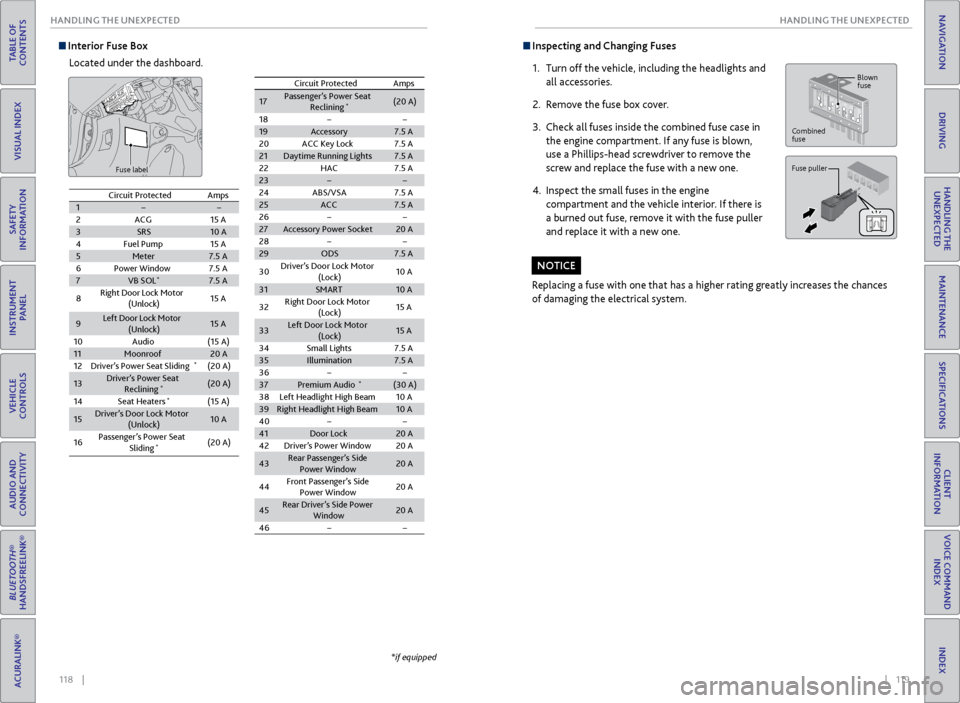
118 || 119
HANDLING THE UNEXPECTED
HANDLING THE UNEXPECTED
TABLE OF
CONTENTS
INDEX
VISUAL INDEX
VOICE COMMAND INDEX
SAFETY
INFORMATION
CLIENT
INFORMATION
INSTRUMENT PANEL
SPECIFICATIONS
VEHICLE
CONTROLS
MAINTENANCE
AUDIO AND
CONNECTIVITY
HANDLING THE UNEXPECTED
BLUETOOTH®
HANDSFREELINK®
DRIVING
ACURALINK®
NAVIGATION
Interior Fuse Box
Located under the dashboard.
Fuse label
*if equipped
Circuit ProtectedAmps1��2ACG15 A3SRS10 A4Fuel Pump15 A5Meter7.5 A6Power Windo w7.5 A7VB SOL*7.5 A
8Right Door Lock Motor
(Unlock)15 A
9Left Door Lock Motor
(Unlock )15 A
10Audio(15 A)11Moonroof20 A12Driver’s Power Seat Slidin g*(20 A)
13Driver’s Power Seat
Reclining*(20 A)
14Seat Heaters*(15 A)
15Driver’s Door Lock Motor (Unlock)10 A
16Passenger’s Power Seat
Sliding*(20 A)
17Passenger’s Power Seat
Reclinin g*(20 A)
18 � �
19 Accessory 7.5 A
20 ACC Key Lock 7.5 A
21 Daytime Running Lights 7.5 A
22 HAC 7.5 A
23 � �
24 ABS/VSA 7.5 A
25 ACC 7.5 A
26 � �
27 Accessory Power Socket 20 A
28 � �
29 ODS 7.5 A
Circuit Protected
Amps
30 Driver’s Door Lock Motor
(Lock) 10
A
31 SMART 10 A
32 Right Door Lock Motor
(Lock) 15
A
33 Left Door Lock Motor
(Lock) 15
A
34 Small Lights 7.5 A
35 Illumination 7.5 A
36 � �
37 Premium Audio
*(30 A)
38 Left Headlight High Beam 10 A
39 Right Headlight High Bea m10 A
40 � �
41 Door Lock 20 A
42 Driver’s Power Window 20 A
43 Rear Passenger’s Side
Power Window 20
A
44 Front Passenger’s Side
Power Window 20
A
45 Rear Driver’s Side Power
Window 20
A
46 � �
Inspecting and Changing Fuses
1. Turn off the vehicle, including the headlights and
all accessories.
2. Remove the fuse box cover.
3. Check all fuses inside the combined fuse case in
the engine compartment. If any fuse is blown,
use a Phillips-head screwdriver to remove the
screw and replace the fuse with a new one.
4. Inspect the small fuses in the engine
compartment and the vehicle interior. If there is
a burned out fuse, remove it with the fuse puller
and replace it with a new one.
Replacing a fuse with one that has a higher rating greatly increases the chances
of damaging the electrical system.
NOTICE
Combined
fuse Blown
fuse
Fuse puller
Circuit Protected
Amps
1 � �
2 ACG 15 A
3 SRS 10 A
4 Fuel Pump 15 A
5 Meter 7.5 A
6 Power Windo w7.5 A
7 VB SOL
*7.5 A
8 Right Door Lock Motor
(Unlock) 15
A
9 Left Door Lock Motor
(Unlock ) 15
A
10 Audio (15 A)
11 Moonroof 20 A
12 Driver’s Power Seat Slidin g
*(20 A)
13 Driver’s Power Seat
Reclining
*(20 A)
14 Seat Heaters
*(15 A)
15 Driver’s Door Lock Motor
(Unlock) 10
A
16 Passenger’s Power Seat
Sliding
*(20 A)
17Passenger’s Power Seat Reclinin g*(20 A)
18��19Accessory7.5 A20ACC Key Lock7.5 A21Daytime Running Lights7.5 A22HAC7.5 A23��24ABS/VSA7.5 A25ACC7.5 A26��27Accessory Power Socket20 A28��29ODS7.5 A
Circuit ProtectedAmps
30Driver’s Door Lock Motor
(Lock)10 A
31SMART10 A
32Right Door Lock Motor
(Lock)15 A
33Left Door Lock Motor
(Lock)15 A
34Small Lights7.5 A35Illumination7.5 A36��37Premium Audio*(30 A)38Left Headlight High Beam10 A39Right Headlight High Bea m10 A40��41Door Lock20 A42Driver’s Power Window20 A
43Rear Passenger’s Side
Power Window20 A
44Front Passenger’s Side
Power Window20 A
45Rear Driver’s Side Power
Window20 A
46��
Page 71 of 78
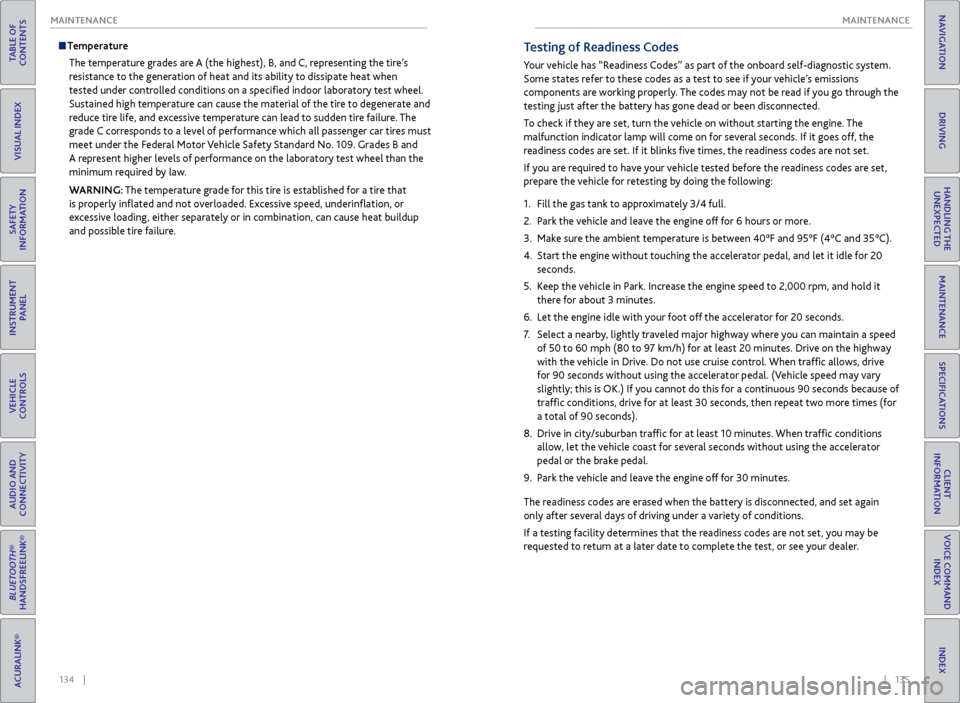
134 || 135
MAINTENANCE
MAINTENANCE
TABLE OF
CONTENTS
INDEX
VISUAL INDEX
VOICE COMMAND INDEX
SAFETY
INFORMATION
CLIENT
INFORMATION
INSTRUMENT PANEL
SPECIFICATIONS
VEHICLE
CONTROLS
MAINTENANCE
AUDIO AND
CONNECTIVITY
HANDLING THE UNEXPECTED
BLUETOOTH®
HANDSFREELINK®
DRIVING
ACURALINK®
NAVIGATION
Temperature
The temperature grades are A (the highest), B, and C, representing the tire’s
resistance to the generation of heat and its ability to dissipate heat when
tested under controlled conditions on a specified indoor laboratory test wheel.
Sustained high temperature can cause the material of the tire to degenerate and
reduce tire life, and excessive temperature can lead to sudden tire failure. The
grade C corresponds to a level of performance which all passenger car tires must
meet under the Federal Motor Vehicle Safety Standard No. 109. Grades B and
A represent higher levels of performance on the laboratory test wheel than the
minimum required by law.
WARNING: The temperature grade for this tire is established for a tire that
is properly inflated and not overloaded. Excessive speed, underinflation, or
excessive loading, either separately or in combination, can cause heat buildup
and possible tire failure.Testing of Readiness Codes
Your vehicle has “Readiness Codes” as part of the onboard self-diagnostic system.
Some states refer to these codes as a test to see if your vehicle’s emissions
components are working properly. The codes may not be read if you go through the
testing just after the battery has gone dead or been disconnected.
To check if they are set, turn the vehicle on without starting the engine. The
malfunction indicator lamp will come on for several seconds. If it goes off, the
readiness codes are set. If it blinks five times, the readiness codes are not set.
If you are required to have your vehicle tested before the readiness codes are set,
prepare the vehicle for retesting by doing the following:
1. Fill the gas tank to approximately 3/4 full.
2. Park the vehicle and leave the engine off for 6 hours or more.
3. Make sure the ambient temperature is between 40°F and 95°F (4°C and 35°C).
4. Start the engine without touching the accelerator pedal, and let it idle for 20
seconds.
5. Keep the vehicle in Park. Increase the engine speed to 2,000 rpm, and hold it
there for about 3 minutes.
6. Let the engine idle with your foot off the accelerator for 20 seconds.
7. Select a nearby, lightly traveled major highway where you can maintain a speed
of 50 to 60 mph (80 to 97 km/h) for at least 20 minutes. Drive on the highway
with the vehicle in Drive. Do not use cruise control. When traffic allows, drive
for 90 seconds without using the accelerator pedal. (Vehicle speed may vary
slightly; this is OK.) If you cannot do this for a continuous 90 seconds because of
traffic conditions, drive for at least 30 seconds, then repeat two more times (for
a total of 90 seconds).
8. Drive in city/suburban traffic for at least 10 minutes. When traffic conditions
allow, let the vehicle coast for several seconds without using the accelerator
pedal or the brake pedal.
9. Park the vehicle and leave the engine off for 30 minutes.
The readiness codes are erased when the battery is disconnected, and set again
only after several days of driving under a variety of conditions.
If a testing facility determines that the readiness codes are not set, you may be
requested to return at a later date to complete the test, or see your dealer.
Page 72 of 78
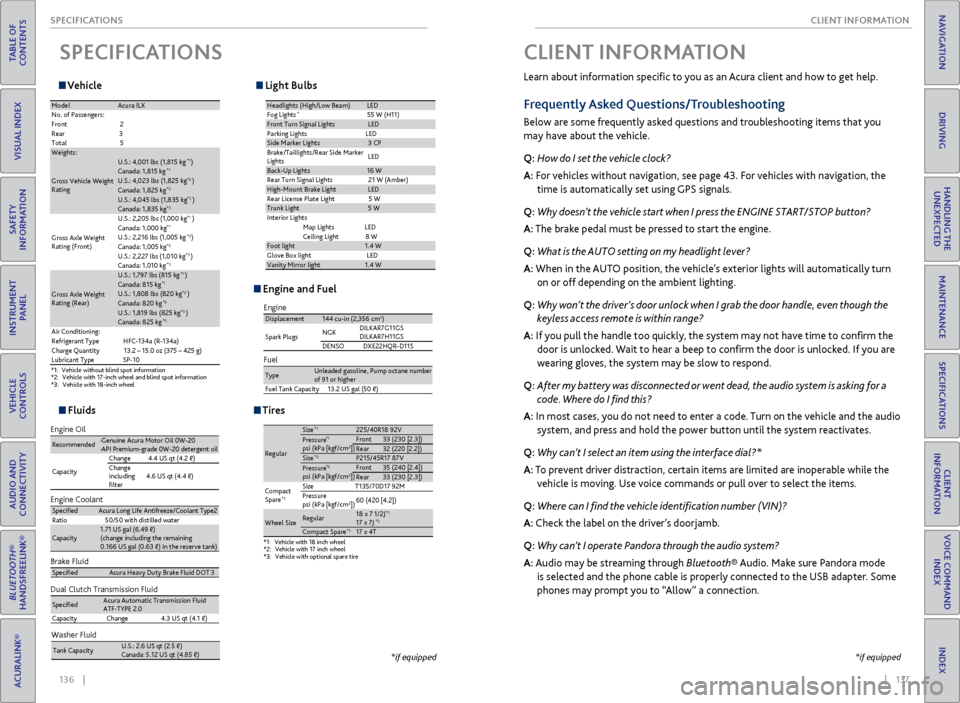
136 || 137
CLIENT INFORMATION
SPECIFICATIONS
TABLE OF
CONTENTS
INDEX
VISUAL INDEX
VOICE COMMAND INDEX
SAFETY
INFORMATION
CLIENT
INFORMATION
INSTRUMENT PANEL
SPECIFICATIONS
VEHICLE
CONTROLS
MAINTENANCE
AUDIO AND
CONNECTIVITY
HANDLING THE UNEXPECTED
BLUETOOTH®
HANDSFREELINK®
DRIVING
ACURALINK®
NAVIGATION
Vehicle
SPECIFICATIONS
*1:V ehicl e without blind spot information *2:Vehicle with 17-inch wheel and blind spot information *3:V ehic le with 18-inc h wheel
ModelAcura IL X
No. of Passengers :
Fron t2
Rear 3
Tota l5
Weights:
Gross Vehicle Weight
Ratin g
U.S.: 4,001 lbs (1,815 kg )*1Canada: 1,815 kg*1U.S.: 4,023 lbs (1,825 kg )*2Canada: 1,825 kg*2U.S.: 4,045 lbs (1,835 kg )*3Canada: 1,835 kg*3
Gross Axle Weight
Rating (Front)U.S.: 2,205 lbs (1,000 kg
)
*1Canada: 1,000 kg*1U.S.: 2,216 lbs (1,005 kg )*2Canada: 1,005 kg*2U.S.: 2,227 lbs (1,010 kg )*3Canada: 1,010 kg*3
Gross Axle Weight
Rating (Rear)
U.S.: 1,797 lbs (815 kg )*1Canada: 815 kg*1U.S.: 1,808 lbs (820 kg )*2Canada: 820 kg*2U.S.: 1,819 lbs (825 kg )*3Canada: 825 kg*3Air Conditioning:
Refrigerant Type HFC-134a (R-134a)
Charge Quantity 13.2 – 15.0 oz (375 – 425 g)
Lubricant Typ eSP-10
Light Bulbs
Headlights (High/Low Beam )LED
Fog Lights*55 W (H11)Front Turn Signal LightsLE D
Parking Lights LED
Side Ma rker Lights3 CP
Brake/Taillights/Rear Side Marker
Light s LE
D
Back-Up Lights16 W
Rear Turn Signal Lights 21 W (Amber)
High-Mount Brake Ligh tLED
Rear License Plate Light 5 W
Trunk Light5 W
In teri or Lights
Map Lights LED
Ceiling Ligh t8 W
Foot light1.4 W
Glove Box lightL ED
Vanity Mirror light1.4 W
Fluids
Brake Fluid
Dual Clutch Transmission Fluid
Speci�e dAcura Heavy Duty Brake Fluid DOT 3
Speci�edAcura Automatic Transmission Fluid
ATF-TYPE 2. 0
Capacity Change4 .3 US qt (4.1�)
Engine Oil
Engine Coolan
t
Recommended·Genuine Acura Motor Oil 0W-2 0
·API Premium-grade 0W-20 detergent oi l
Capacity Change
4.4 US qt (4.2 �)
Change
including
�lter 4.6 US qt (4.4 �)
Speci�e
dAcura Long Life Antifreeze/Coolant Type 2
Ratio 50/50 with distilled wate r
Capacity1.71 US gal (6.49 �)
(change including the remaining
0.166 US gal (0.63 �) in the reserve tank )
Washer Fluid
Tank Capacit yU.S.: 2.6 US qt (2.5 �)
Canada: 5.12 US qt (4.85 �)
Engine and Fuel
Engine
FuelDisplacement144 cu-in (2,356 cm3)
Spark Plugs NG
K DILKAR7G11GS
DILKAR7H11GS
DENSO DXE22HQR-D11S
TypeUnleaded gasoline, Pump octane number of 91 or higher
Fuel Tank Capacity 13.2 US gal (50 �)
Tires
*1:Vehicle with 18 inch wheel*2:Vehicle with 17 inch wheel*3: Vehicle with optional spare tire
Regular
Size*1225/40R18 92 VPressure*1psi (kPa [kgf/cm2Front33 (230 [2.3])Rear32 (220 [2.2])Size*2P215/45R17 87 VPressure*2psi (kPa [kgf/cm2Front35 (240 [2.4])Rear33 (230 [2.3])
Compact
Spar e
*3Size T135/70D17 92M
Pressure
psi (kPa [kgf/cm
2]) 60 (420 [4.2])
Wheel SizeRegula
r18 x 7 1/2J*117 x 7J*2Compact Spar e*317 x 4T
])
])
*if equipped
Learn about information specific to you as an Acura client and how to get help.
Frequently Asked Questions/Troubleshooting
Below are some frequently asked questions and troubleshooting items that you
may have about the vehicle.
Q: How do I set the vehicle clock?
A: For vehicles without navigation, see page 43. For vehicles with navigation, the
time is automatically set using GPS signals.
Q: Why doesn’t the vehicle start when I press the ENGINE START/STOP button?
A: The brake pedal must be pressed to start the engine.
Q: What is the AUTO setting on my headlight lever?
A: When in the AUTO position, the vehicle’s exterior lights will automatically turn
on or off depending on the ambient lighting.
Q: Why won’t the driver’s door unlock when I grab the door handle, even though the
keyless access remote is within range?
A: If you pull the handle too quickly, the system may not have time to confirm the
door is unlocked. Wait to hear a beep to confirm the door is unlocked. If you are
wearing gloves, the system may be slow to respond.
Q: After my battery was disconnected or went dead, the audio system is asking for a
code. Where do I find this?
A: In most cases, you do not need to enter a code. Turn on the vehicle and the audio
system, and press and hold the power button until the system reactivates.
Q: Why can’t I select an item using the interface dial?*
A: To prevent driver distraction, certain items are limited are inoperable while the
vehicle is moving. Use voice commands or pull over to select the items.
Q: Where can I find the vehicle identification number (VIN)?
A: Check the label on the driver’s doorjamb.
Q: Why can’t I operate Pandora through the audio system?
A: Audio may be streaming through Bluetooth® Audio. Make sure Pandora mode
is selected and the phone cable is properly connected to the USB adapter. Some
phones may prompt you to “Allow” a connection.
CLIENT INFORMATION
*if equipped
Page 77 of 78
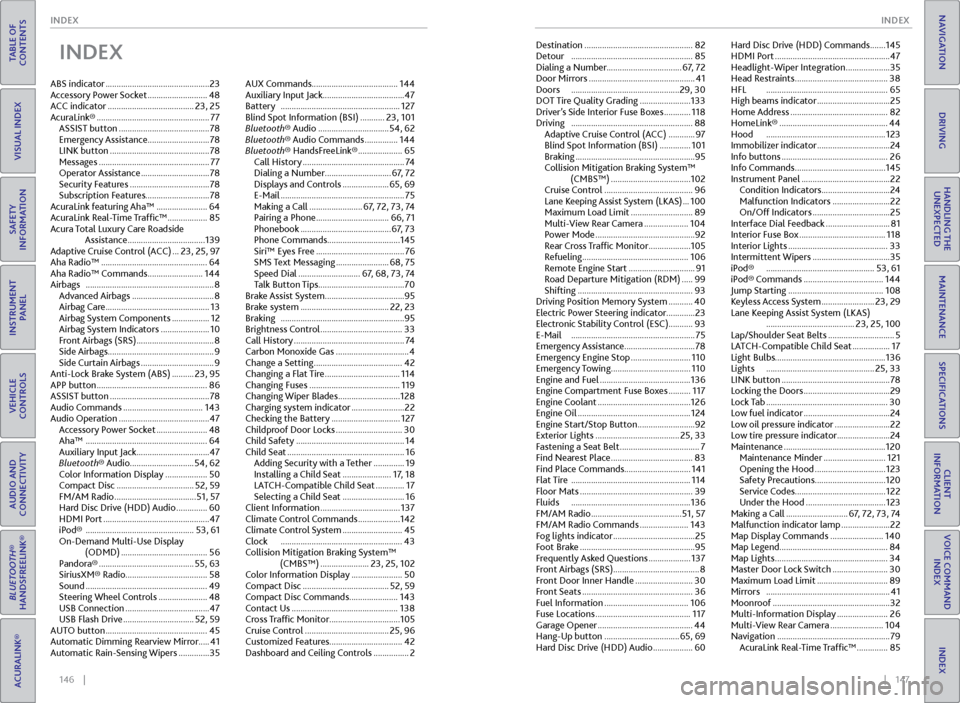
146 || 147
INDEX
INDEX
TABLE OF
CONTENTS
INDEX
VISUAL INDEX
VOICE COMMAND INDEX
SAFETY
INFORMATION
CLIENT
INFORMATION
INSTRUMENT PANEL
SPECIFICATIONS
VEHICLE
CONTROLS
MAINTENANCE
AUDIO AND
CONNECTIVITY
HANDLING THE UNEXPECTED
BLUETOOTH®
HANDSFREELINK®
DRIVING
ACURALINK®
NAVIGATION
INDEX
ABS indicator ............................................... 23
Accessory Power Socket ........................... 48
ACC indicator ....................................... 23, 25
AcuraLink® ................................................... 77
ASSIST button ......................................... 78
Emergency Assistance ............................ 78
LINK button ............................................. 78
Messages .................................................. 77
Operator Assistance ............................... 78
Security Features .................................... 78
Subscription Features .............................78
AcuraLink featuring Aha™ ....................... 64
AcuraLink Real-Time Traffic™ .................. 85
Acura Total Luxury Care Roadside Assistance ................................... 139
Adaptive Cruise Control (ACC) ... 23, 25, 97
Aha Radio™ ................................................ 64
Aha Radio™ Commands ......................... 144
Airbags .......................................................... 8
Advanced Airbags ..................................... 8
Airbag Care ............................................... 13
Airbag System Components ................. 12
Airbag System Indicators ...................... 10
Front Airbags (SRS) ................................... 8
Side Airbags ................................................ 9
Side Curtain Airbags ................................. 9
Anti-Lock Brake System (ABS) .......... 23, 95
APP button .................................................. 86
ASSIST button ............................................. 78
Audio Commands .................................... 143
Audio Operation ......................................... 47
Accessory Power Socket ....................... 48
Aha™ ....................................................... 64
Auxiliary Input Jack ................................. 47
Bluetooth® Audio .............................54, 62
Color Information Display ................... 50
Compact Disc ................................... 52, 59
FM/AM Radio ..................................... 51, 57
Hard Disc Drive (HDD) Audio .............. 60
HDMI Port ................................................ 47
iPod® ................................................. 53, 61
On-Demand Multi-Use Display (ODMD) ....................................... 56
Pandora® ........................................... 55, 63
SiriusXM® Radio..................................... 58
Sound ....................................................... 49
Steering Wheel Controls ...................... 48
USB Connection ...................................... 47
USB Flash Drive ................................ 52, 59
AUTO button .............................................. 45
Automatic Dimming Rearview Mirror .....41
Automatic Rain-Sensing Wipers .............. 35AUX Commands
....................................... 144
Auxiliary Input Jack ..................................... 47
Battery ...................................................... 127
Blind Spot Information (BSI) ........... 23, 101
Bluetooth® Audio ................................ 54, 62
Bluetooth® Audio Commands ............... 144
Bluetooth® HandsFreeLink® .................... 65
Call History .............................................. 74
Dialing a Number .............................. 67, 72
Displays and Controls ..................... 65, 69
E-Mail ........................................................ 75
Making a Call ........................ 67, 72, 73, 74
Pairing a Phone ................................. 66, 71
Phonebook ......................................... 67, 73
Phone Commands .................................145
Siri™ Eyes Free ........................................ 76
SMS Text Messaging ........................ 68, 75
Speed Dial ............................ 67, 68, 73, 74
Talk Button Tips ....................................... 70
Brake Assist System .................................... 95
Brake system ........................................ 22, 23
Braking ........................................................ 95
Brightness Control ..................................... 33
Call History .................................................. 74
Carbon Monoxide Gas ................................. 4
Change a Setting ........................................ 42
Changing a Flat Tire .................................. 114
Changing Fuses ......................................... 119
Changing Wiper Blades ............................ 128
Charging system indicator ........................ 22
Checking the Battery ............................... 127
Childproof Door Locks .............................. 30
Child Safety ................................................. 14
Child Seat ..................................................... 16
Adding Security with a Tether .............. 19
Installing a Child Seat ...................... 17, 18
LATCH-Compatible Child Seat ............. 17
Selecting a Child Seat ............................ 16
Client Information .................................... 137
Climate Control Commands ................... 142
Climate Control System ........................... 45
Clock ....................................................... 43
Collision Mitigation Braking System™ (CMBS™) ...................... 23, 25, 102
Color Information Display ....................... 50
Compact Disc ....................................... 52, 59
Compact Disc Commands ...................... 143
Contact Us ................................................ 138
Cross Traffic Monitor ................................ 105
Cruise Control ...................................... 25, 96
Customized Features .................................42
Dashboard and Ceiling Controls ................ 2Destination .................................................
82
Detour ....................................................... 85
Dialing a Number .................................. 67, 72
Door Mirrors ................................................ 41
Doors ................................................. 29, 30
DOT Tire Quality Grading ....................... 133
Driver’s Side Interior Fuse Boxes ............ 118
Driving ....................................................... 88
Adaptive Cruise Control (ACC) ............ 97
Blind Spot Information (BSI) .............. 101
Braking ...................................................... 95
Collision Mitigation Braking System™ (CMBS™) .................................... 102
Cruise Control ........................................ 96
Lane Keeping Assist System (LKAS) ... 100
Maximum Load Limit ............................ 89
Multi-View Rear Camera .................... 104
Power Mode ............................................. 92
Rear Cross Traffic Monitor ................... 105
Refueling ................................................ 106
Remote Engine Start .............................. 91
Road Departure Mitigation (RDM) ..... 99
Shifting .................................................... 93
Driving Position Memory System ........... 40
Electric Power Steering indicator .............23
Electronic Stability Control (ESC)........... 93
E-Mail ........................................................ 75
Emergency Assistance ................................78
Emergency Engine Stop ........................... 110
Emergency Towing ....................................
110
Engine and Fuel ......................................... 136
Engine Compartment Fuse Boxes .......... 117
Engine Coolant .......................................... 126
Engine Oil ................................................... 124
Engine Start/Stop Button .......................... 92
Exterior Lights ...................................... 25, 33
Fastening a Seat Belt .................................... 7
Find Nearest Place ..................................... 83
Find Place Commands .............................. 141
Flat Tire ...................................................... 114
Floor Mats ................................................... 39
Fluids ...................................................... 136
FM/AM Radio ......................................... 51, 57
FM/AM Radio Commands ...................... 143
Fog lights indicator ..................................... 25
Foot Brake .................................................... 95
Frequently Asked Questions ................... 137
Front Airbags (SRS) ....................................... 8
Front Door Inner Handle .......................... 30
Front Seats .................................................. 36
Fuel Information ...................................... 106
Fuse Locations ........................................... 117
Garage Opener ........................................... 44
Hang-Up button .................................. 65, 69
Hard Disc Drive (HDD) Audio .................. 60Hard Disc Drive (HDD) Commands .......
145
HDMI Port .................................................... 47
Headlight-Wiper Integration .................... 35
Head Restraints .......................................... 38
HFL ....................................................... 65
High beams indicator ................................. 25
Home Address ............................................ 82
HomeLink® ................................................. 44
Hood ...................................................... 123
Immobilizer indicator ................................. 24
Info buttons ................................................ 26
Info Commands ......................................... 145
Instrument Panel ........................................ 22
Condition Indicators ............................... 24
Malfunction Indicators .......................... 22
On/Off Indicators ................................... 25
Interface Dial Feedback ............................. 81
Interior Fuse Box ....................................... 118
Interior Lights ............................................. 33
Intermittent Wipers ................................... 35
iPod® ................................................. 53, 61
iPod® Commands .................................... 144
Jump Starting ........................................... 108
Keyless Access System ........................ 23, 29
Lane Keeping Assist System (LKAS) ........................................ 23, 25, 100
Lap/Shoulder Seat Belts .............................. 5
LATCH-Compatible Child Seat ................. 17
Light Bulbs .................................................. 136
Lights ................................................. 25, 33
LINK button ................................................. 78
Locking the Doors ....................................... 29
Lock Tab ....................................................... 30
Low fuel indicator ....................................... 24
Low oil pressure indicator ......................... 22
Low tire pressure indicator ........................24
Maintenance .............................................. 120
Maintenance Minder ............................ 121
Opening the Hood ................................ 123
Safety Precautions ................................ 120
Service Codes ......................................... 122
Under the Hood .................................... 123
Making a Call ............................ 67, 72, 73, 74
Malfunction indicator lamp ...................... 22
Map Display Commands ........................ 140
Map Legend ................................................. 84
Map Lights ................................................... 34
Master Door Lock Switch ......................... 30
Maximum Load Limit ................................ 89
Mirrors ........................................................ 41
Moonroof ..................................................... 32
Multi-Information Display ....................... 26
Multi-View Rear Camera ........................ 104
Navigation ................................................... 79
AcuraLink Real-Time Traffic™ .............. 85